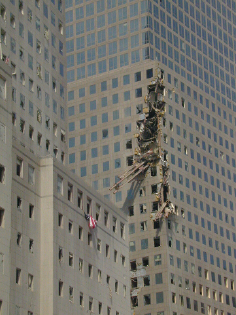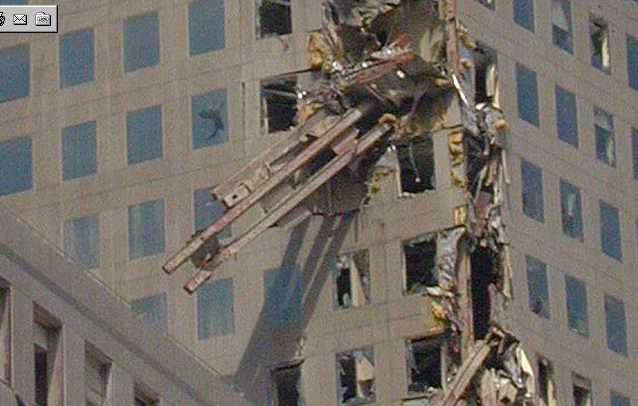|
The story...
Photos of the WTC collapse clearly show steel columns cut into small pieces, ejected at great force from the building, something that could only happen through controlled demolition..

Our take...
We’ve not annotated the above photo, but when it’s used you’ll usually you’ll see arrows pointing to the bars on the extreme right. This, it’s claimed is the steel. Sometimes you’ll also see distance estimates, suggesting that the objects are being ejected for x hundred feet (whatever the author has calculated).
One problem with this, particularly when looking at stills, is you don’t know where the debris came from. The bars on the extreme right here don’t appear to have been ejected horizontally from the tower, for instance, because it still looks intact. And so they came from above, but how far? It matters if you’re trying to determine the force required, and whether it exceeds that available from the downward momentum of the collapse.
But there’s another issue, too. The WTC had a relatively light aluminium facade, and we suspect that’s what you’re seeing in the bars at the outer edge of the debris (at least in this and similar shots). Here’s a pre-collapse shot for comparison.

You can see strips on the facade hanging loose, and it looks like they’re about a floor high. We’d suggest these are likely to be the strips you can see at the outer edge of the collapse debris photos, not structural steel, which itself is visible on the left hand /centre side.
Of course there are other examples where there’s no question that structural steel has been propelled for some considerable distance. Here’s one example:
 |
The photo title on a Government site tells us:
Ohio Task Force workers anchored this 600,000-pound beam from the World Trade Center lodged in a nearby building.
http://www.911da.org/crr/images/CRRDB/data/documents/3424.htm
And some have concluded that this can only happen through explosives:
No bombs – no 600,000 pound beam flying over 390 feet and piercing into the other building.
http://www.gallerize.com/WINDY_TOWERS_OF_9-11_1.htm
However, you’ll note there’s rarely any attempt to prove this: it’s usually just someone saying “well, it’s obvious, isn’t it?” So let’s consider a few facts.
First, the reported weight of this particular beam is quoted as “600,000 pounds”, or 300 tons. But as each WTC tower is generally said to have used 200,000 tons of steel, that means this beam is supposed to represent 0.15% of the entire structure, or around one sixth of the structural steel required for a single floor. Now, a close up shot shows there is a big chunk of steel there, but “600,000 pounds”? We don’t think so.
A more likely explanation seems to be that there’s a typo in the original FEMA estimate, and they actually meant “60,000 pounds” (although even that may be an overestimate).
Still, it remains a sizable piece of debris. How fast would it have to be thrown to cover this 390 foot distance? If the beam came from the 90th floor of WTC1, that would put it 1119 feet up. The debris hit around half way up WFC 3, we’ll call that 369 feet for convenience: that’s a fall of 750 feet. Freefall from that height gives the debris around 6.83 seconds to travel through the air, meaning it would need to average a horizontal velocity of 57.1 feet per second, or 38.94 miles per hour.
Is this possible? The following analysis, emailed to us, suggests so, even though later comments suggest it originated with someone sceptical of the official story. Unfortunately the text came second-hand, with no information about the author: if this is yours, or you recognise it, please email details and we’ll add the appropriate credit.
In order to allow time for lateral motion, the exterior column(s) that hit WFC 3 were most probably from the upper half of WTC 1. A fall from 1,000 feet to 240 feet would take SQR(2*h/g) = around 6.9 seconds where h = 760 feet and g = 32.17 ft/s^2. In the horizontal plane, a uniform acceleration of 20 m/s^2 for the first second followed by negligible deceleration due to drag for the remaining 5.9 seconds would provide 10 + (5.9 * 20) = 128 metres = 420 feet displacement. At 1,000 feet the WTC 1 perimeter columns, per story, were comprised of:
two flanges of 1/2 x 13.5 x 144 inches each, totalling 1,944 ins^3
one outer web of 1/4 x 13 x 144 inches = 468 ins^3
one inner web of 1/4 x 15.75 x 92 inches = 362 ins^3
one spandrel plate of 3/8 x 40 x 52 inches = 780 ins^3
...totalling 3,554 ins^3 per floor or 10,662 ins^3 = 6.17 ft^3 for a three-floor section which at 490 lb/ft^3 is 3,023 lb (84 pounds per lineal foot) or 1,371 kg. (There is some uncertainty as to the flange thickness; it was known to be only 1/4" at the very highest floors.) The force require to produce an acceleration of 20 m/s^2 in an inertia mass of 1,371 kg is 20 * 1371 = 27,420 N = 6,165 lbf.
The cross-section presented to a wind, per floor, would be 40 x 52 = 2,080 ins^2 for the spandrel plate and 15.75 x 92 = 1,449 ins^2 for the inner web, totalling 3,529 ins^2 per floor or 10,587 ins^2 = 6.83 m^2 for a three-story section of exterior column. (So the required pressure is well under 1 psi.) From the drag equation of
d = Cd * A * r * 0.5 * v^2
we obtain
v = SQR(2 * d / (Cd * A * r))
where r = density of air ~ 1.2 kg/m^3 and assuming a relatively high drag coefficient Cd of 4 / pi ~ 1.27 for a flat plate and d = the previously calculated force of 27,420 N and A = 6.83 m^2 as calculated above. This places the required wind at 72.6 m/s = 162 mph for one second duration. Actual windspeed on the day was up to 10 mph on the ground and up to 20 mph at higher altitude.
Suppose we imagine the collapse initiating at 1,200 feet, and proceeding as per the "pancaking" theory to 1,000 feet. After freely falling 200 feet, the terminal velocity would be SQR(2 * 200 * 32.17 ft/s^2) = 113.4 fps = 77.3 mph. In this theory, there is a small delay due to resistance of the intact building below, but the falling upper section smashes its way through each floor in about 0.1 seconds at the 1,000 feet level. The volume of air per floor is approximately 12 * 200 * 200 feet = 480,000 ft^3. Some will go down, but if the total was forced out through a perimeter of 800 feet by an average height of 6 feet which is an exiting area of 4,800 ft^2, it would (continuing outward) extend for some 100 feet at the end of the 0.1 seconds which is a velocity of 1,000 fps or 682 mph.
Let's set the exiting gases velocity at just 700 fps = 213 m/s, in which case the force acting on the exterior column for 0.1 seconds is given by:
d = Cd * A * r * 0.5 * v^2
= 1.27 * 6.83 * 1.2 * 0.5 * 213^2 ~ 236,000 N
to produce an acceleration of F / m = 236,000 N / 1,371 kg = 172 m/s^2. After 0.1 seconds the velocity of the steel is 17.2 m/s = 38.5 mph, and the horizontal displacement is 0.86 metres. Following another 6.8 seconds at 17.2 m/s the total distance travelled horizontally is 0.86 plus 6.8 * 17.2 ~ 118 metres = 387 feet. The columns have to shear off quickly enough, and the pancaking theory has the problem that the gravitational potential appears to be too low for all the energy sinks, but even this scenario does not appear to rule out the idea that debris could end up a few hundred feet away.
|



